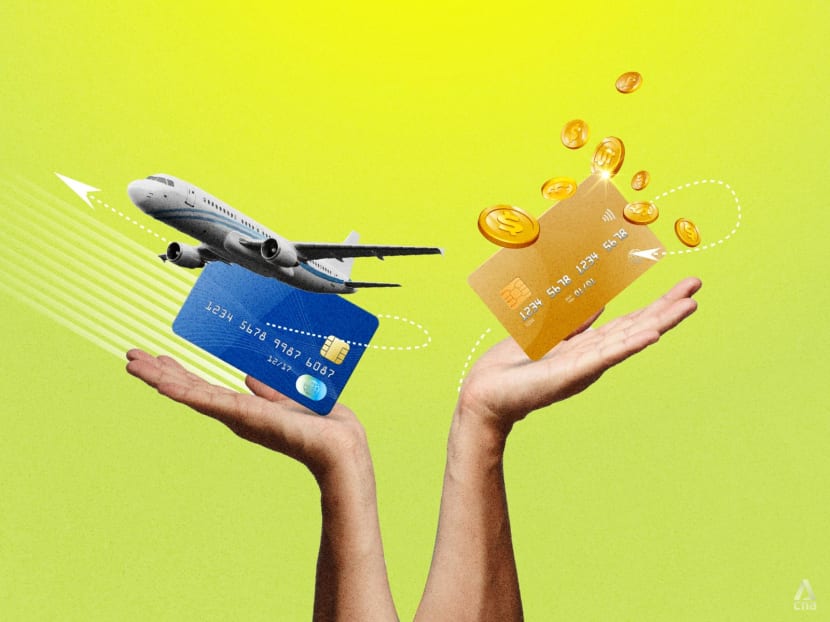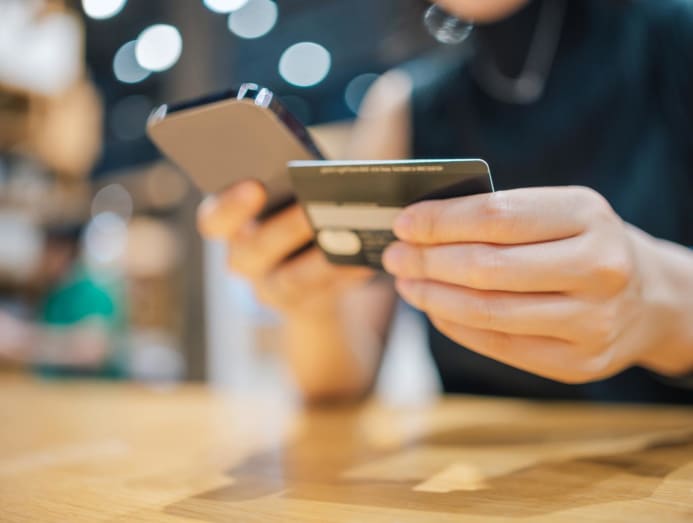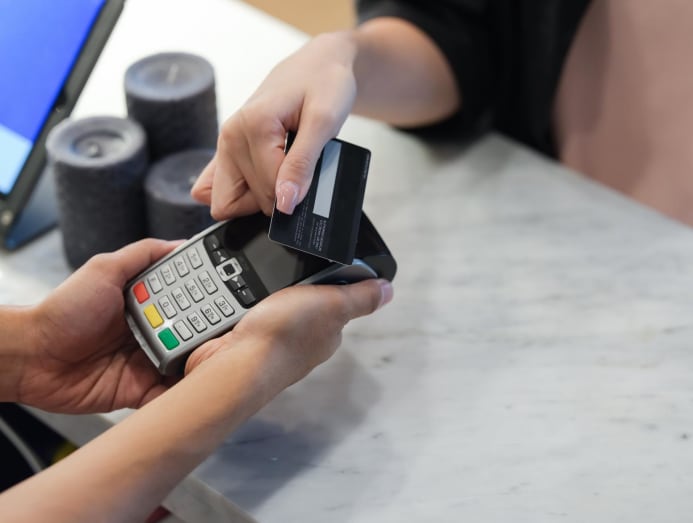Why I switched from cashback credit cards to miles
Can't decide on the best credit cards for you? Focus on your spending habits and personal preferences, finance blogger Dawn Cher says.

Credit cards that offer travel miles as rewards give value without the user doing too much planning and calculating, while cashback cards are appealing for their no-frills-no-fuss nature, personal finance blogger Dawn Cher said. (Illustration: CNA/Samuel Woo, iStock)

This audio is generated by an AI tool.
When it comes to personal finance, one of Singaporeans’ favourite conversation topics is the eternal debate between miles and cashback.
Throughout my 20s, I relied mostly on "cashback" credit cards, which gives you back a percentage of the money you spend. As a single adult then spending less than S$800 each month, even if I had managed to redeem four miles for each dollar spent, after an entire year, I would have just enough for a one-way business class flight to Philippines – flight time of three hours.
Back then, it just made the most sense for me to choose credit cards that would put cash back in my pocket. However, that changed after I became a parent and started shouldering bigger household expenses.
HOW CREDIT CARD REWARDS GENERALLY WORK
Rewards aside, there are generally two kinds of credit cards: Cards for general spending and cards for specialised spending.
General spending cards are easier to manage, since you don’t have to think about using the right card for the right merchant or hitting a minimum spending requirement each month. However, the trade-off for this convenience is a much lower reward rate, such as a 1 per cent to 2 per cent cashback or one to two miles per dollar.
In contrast, specialised spending cards give far more generous rewards each time you spend. You could be earning as much as 10 per cent cashback or four to 10 miles per dollar each time you spend.
With specialised cards, you need to ensure you’re using the right card for the right merchant(s), but the good thing is that these cards usually do not require a minimum spending. You can spread out your expenses across different cards.
THE PROS AND CONS OF CASHBACK CARDS
Most cashback cards in Singapore today can give you anywhere between 1.5 per cent to 10 per cent cash rebates, which gets added to your monthly credit card bill so that you end up having to pay less than what you actually spent.
For instance, a cashback card like the UOB EVOL will give you 10 per cent cashback on anything you pay for online or with your mobile contactless wallets.
You can also get 10 per cent cashback when you spend in foreign currency in-store while you’re overseas. All other categories of spending get you 0.3 per cent cashback.
That sounds good until you read the caveats: A minimum spending of S$800 is first required, and the bank caps your cashback reward at S$30 for online and mobile transactions, S$20 for overseas ones, and S$30 for all other spending.
In order to get the maximum cashback, you will first need to spend S$300 online, S$200 in-stores overseas, and S$10,000 in other categories. How many cardholders will be able to consistently spend that every month?

Let’s say you’re only hitting the minimum spending of S$800. Even with that S$800 divided in these exact proportions, you will only get back S$50.90 from the bank. Your effective cashback rate now falls to 6.3 per cent instead of the advertised 10 per cent.
Didn’t travel that month? Splitting your S$800 evenly between online purchases and dining gets you only S$31.20 in cashback or 3.9 per cent.
In both instances, you spent S$800, but the cashback you received was different based on the criteria you managed to meet.
Let’s compare this with a general spending card: OCBC Infinity. This card gives you a flat rate of 1.6 per cent cashback across almost all spending categories with no minimum spending and no limit to how much cashback you can earn.
Spending S$800 on this card earns you S$12.80 cashback. To most people, that would hardly sound attractive.
However, if you add up everything you would need to spend on the UOB EVOL for maximum S$80 cashback (S$300 on online, S$200 overseas, and S$10,000 in all other categories) it comes to S$10,500.
With OCBC Infinity, this same expenditure gets you S$168 cashback.
THE PROS AND CONS OF MILES CARDS
When I became a wife and then mother, my monthly expenses ballooned beyond a few hundred dollars to a few thousand. It quickly became a pain to manage cashback cards since they come with more restrictions.
No matter how I worked within my arsenal of cashback cards, the various rebate limits and category caps of each card made it almost impossible for me to match every dollar to some form of acceptable cashback yield each month.
After trying for a year, I finally gave up and switched over to miles credit cards instead.
Nowadays, miles cards are far easier for me to manage. I can optimise my spending by simply using specific high specialised cards (four to 10 miles per dollar) for each category of my expenses, and putting everything else on a general card (1.2 to three miles per dollar).
I only need to worry about hitting the monthly maximum spending cap on each card, which is easy enough to track on banking apps. I often automate this by adjusting spending limits on my cards.

Once I’ve accumulated enough miles, I redeem them for free flights or hotel stays for my family’s next holiday.
By paying for our insurance premiums, tuition fees, groceries and other household expenses mostly via miles credit cards, I managed to clock enough miles to fly my husband and I on an 18-hour business class flight from New York to Singapore for just S$100 (in airport taxes) last year.
But while accumulating miles is typically more straightforward, redeeming them can be a different story.
Travel rewards programmes often come with blackout dates and limited seat availability, which can potentially make using miles challenging.
I’ve had to book flights months and months ahead of time, camp online for slots, and even switch to a different destination before my miles expired. (Some also pay to extend their miles validity – but in my view, this doesn’t always make financial sense.)
What’s more, miles are subject to the risk of devaluation at the airline’s discretion, which potentially diminishes the value of the miles I've accumulated over time.
WHAT SHOULD YOU CHOOSE?
Cashback cards are appealing for their no-frills-no-fuss nature. You simply get a percentage of your spending back – but if you’re unable to micro-manage your expenses, then the value of your rewards can drop significantly.
On the other hand, miles cards offer better value without requiring too much planning and calculating – but may not be so helpful if you don’t travel all that much.
Ultimately though, the miles-versus-cashback debate is one that offers no neat resolution.
There is no such thing as “the best” credit card in Singapore.
Winning the credit card game isn’t about choosing an all-powerful trump card (pun intended) – it’s about what your money usually goes to each month and where.
If you can manage multiple cards, using specialised cards will obviously get you the highest rewards. However, this requires some planning and strategic spending – so if you don’t have the time or energy, opting for a general card that rewards you across most of your existing spending categories will most likely work better for you.
Don’t get distracted by the endless parade of credit card rewards available to you. Instead, let your spending habits and personal preferences take the wheel.
Dawn Cher, also known as SG Budget Babe, has been running a popular blog on personal finance for the last 10 years.












